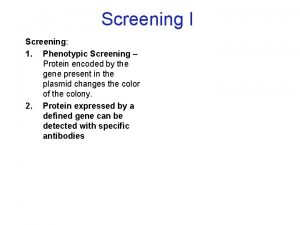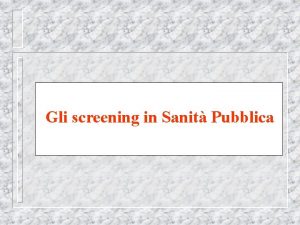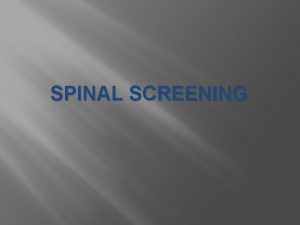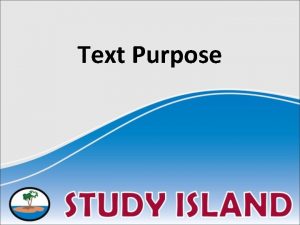The purpose of screening is to determine F











- Slides: 11

The purpose of screening is to determine: F whether or not a proposal requires an EIA F what level of EIA is required UNEP Training Resource Manual 1

Outcomes of screening F full or comprehensive EIA required F more limited EIA required F further study needed to determine EIA requirement F no further requirement for EIA UNEP Training Resource Manual 2

Screening and scoping compared Screening F determines the requirement for EIA F establishes the level of review necessary Scoping F identifies the key issues and impacts F establishes UNEP Training Resource Manual the terms of reference 3

Screening methods F legal/policy definition F inclusion list of projects (with or without thresholds) F exclusion list of projects F criteria for case-by-case screening UNEP Training Resource Manual 4

A framework for screening Mand atory EIA Increasing impact of development ‘Inclu sive’ threshold Case by case consi deration of require ment for EIA mor e likely to be required; screen border line pro posals for significant en vironme ntal effects ‘Indic ative ’ threshold EIA less l ikely to be req uired but still scr een for significance where the location is s ensitive or if the re is a p otent ial for cumu l ative eff ect s ‘ Exclusive’ threshol d EIA ruled out UNEP Training Resource Manual Topic 4 Slide 5 5

Extended screening methods F initial environmental evaluation or examination (IEE) F environmental overview F class screening UNEP Training Resource Manual 6

Typical proposals requiring a full EIA F dams and reservoirs F (re)settlement and urban development F infrastructure (e. g. transport and sanitation) F industrial facilities (e. g. manufacturing plants) F energy and minerals extraction (e. g. oil & gas, coal) F waste management and disposal of hazardous and toxic materials F energy development (power stations, transmission lines, pipelines) UNEP Training Resource Manual 7

Location and environmental criteria for case-by-case screening The following are important in determining significant effects: ¨ assimilative capacity of the natural environment ¨ environmental sensitivity, e. g. wetlands, coastal and mountain zones ¨ environmental standards and objectives ¨ adjacent to protected or designated areas ¨ within landscapes of special heritage value ¨ existing land use(s) and commitments ¨ abundance and quality of natural resources UNEP Training Resource Manual 8

Extended screening – information required by decision-makers F description of the proposal F conditions and characteristics of the environment F applicable policy, planning and regulatory objectives F identification of potential impacts F degree of public concern and interest UNEP Training Resource Manual 9

An Initial Environmental Examination (IEE) F describes the proposal F considers alternatives F addresses the concerns of the community F identifies potential environmental effects F establishes mitigation measures F includes monitoring and follow up (as necessary) UNEP Training Resource Manual 10

Generalised EIA Process Flowchart Proposal Identification Screening EIA Required Initial environmental examination No EIA *Public involvement Scoping Impact analysis Mitigation and impact management *Public involvement typically occurs at these points. It may also occur at any other stage of the EIA Process. EIA Report Review *Public involvement Resubmit Redesign Decision-making Information from this process contributes to effective future EIA Not approved Approved Implementation and follow up UNEP Training Resource Manual 11
 Lời thề hippocrates
Lời thề hippocrates Cách giải mật thư tọa độ
Cách giải mật thư tọa độ Vẽ hình chiếu đứng bằng cạnh của vật thể
Vẽ hình chiếu đứng bằng cạnh của vật thể Chụp phim tư thế worms-breton
Chụp phim tư thế worms-breton Quá trình desamine hóa có thể tạo ra
Quá trình desamine hóa có thể tạo ra Khi nào hổ mẹ dạy hổ con săn mồi
Khi nào hổ mẹ dạy hổ con săn mồi điện thế nghỉ
điện thế nghỉ Các châu lục và đại dương trên thế giới
Các châu lục và đại dương trên thế giới Các loại đột biến cấu trúc nhiễm sắc thể
Các loại đột biến cấu trúc nhiễm sắc thể Biện pháp chống mỏi cơ
Biện pháp chống mỏi cơ Bổ thể
Bổ thể Làm thế nào để 102-1=99
Làm thế nào để 102-1=99





















